
2017’s Best Reviewed or Seen & Noted Vegan- & Vegetarian-Friendly Cookbooks.
Late this year I had a realization of sorts when I saw the cookbook
Vegan, Vegetarian, Omnivore: Dinner for Everyone at the Table by Ana Thomas, 2016.
See books on herbs, nutrition and Ayruveda in this post
Gift book selections for the cooks in your life are made based on content and originality and are not listed in any particular order.
1. Vegan, Vegetarian, Omnivore: Dinner for Everyone at the Table by Ana Thomas, 2016.
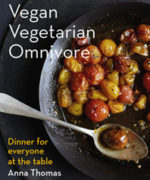
In Vegan, Vegetarian, Omnivore Thomas describes dinners and celebrations with family members and loved ones who could be characterized as other than vegan and vegetarian. But these family members are her people, her tribe. She loves them anyway, despite that their food preferences are totally opposite hers (Ana Thomas wrote the definitive classic The Vegetarian Epicure, c1978)—her ideals were created over decades of dedication to a certain way of preparing food, food without animal products. Vegan, Vegetarian, Omnivore is a large coffee-table sized book with loads of good photography and cooking advice. It’s a great help to the hostess and/or host faced with a variety of diners and would-be fans, if only there could be something they like, or love to eat, on the table for the holidays. Author Thomas provides recipes for celebrations for all kinds of eaters, such as vegetarian, pescatarian, or omnivore. It’s wonderful for someone like myself, so completely given to meatless, that I loved Vegan, Vegetarian, Omnivore for its gentle reminder—no, actually clear recommendation—to love your guests with food. Every one of them.
2. Bitter by Jennifer McLagan, 2014.
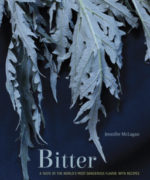
“Born to be Bitter” is the first of six sections in the book, Bitter by Jennifer McLagan. In it she describes the bitter taste stars of the vegetable kingdom along with fruits, drinks like coffee and tea, bitters for alcoholic drinks, and chocolate and tobacco (surprise!) rounding out the selection.
Incorporating bitter into your kitchen repertoire is what, according to McLagan, makes you a savvy chef. If you try a little bit at a time, bitter will grow on you. And you’ll find yourself discovering more about bitterness and how attractive it is. According to McLagan, “food without bitterness lacks depth and complexity.”
See a review of Bitter in my post “Born to be Bitter isn’t such a Bad Thing!”
3. Citrus: Recipes that Celebrate the Sour and the Sweet. by Katherine Phipps, 2017.

When author Phipps says:
she’s referring to the variety of ways we rely on citrus in any season to flavor any dish at our breakfasts, lunches, dinners, snacks, drinks, condiments… you name it and likely there’s a citrus component rendering the dish memorable.
Beginning with “Citrus Economy and Savoury Preserves”, this beautiful book is presented in yellow-golden tones, a brilliant color that indicates each chapter. Recipes are well-presented and prefaced with her personal remarks, in an engaging style.
Phipps wants you to know about making condiments and preserving citrus because they make delicious food possible when you don’t have time. Citrus oil, preserved citrus and Citrus salts and rubs are basic, easy to make, and add sparkle to your dishes with just a bit of effort.
4. The New Wildcrafted Cuisine : Exploring the Exotic Gastronomy of Local Terroir by Pascal Baudar, 2016 in “Wilding Your Table”
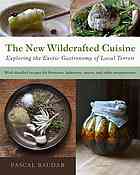
Wherever you live, the local territory has special tastes for your kitchen. In The New Wildcrafted Cuisine, Pascal Baudar relates how he foraged for food in the mountains and shorelines of the city of Los Angeles. Baudar’s technique for acquiring the taste of native foods is something anyone can master in any city or town. He perfected methods for these foods, not only for his own research into new flavors, but also for area chefs who had this quest.
See a review of The New Wildcrafted Cuisine in my post “Wilding Your Table”
5. World Spice at Home: New Flavors for 75 Favorite Dishes by Amanda Bevill and Julie Kramis Hearne. Photography by Charity Burgraaf, 2014.
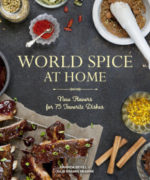
But for the sections on your spice pantry and spice blends that precede the recipes, I would have put this book down as having interest only for omnivores (and therefore not fitting for Lotus Lady and Verse). These two—the spice pantry and blends—are worth more than a quick scan, as they contain quite a lot of helpful information plus photographs of each spice, and that helps sort out the almost overwhelming domain of flavors and tastes that spices represent.
Actually, World Spice at Home contains quite a few recipes that vegetarians can use for mains. Always on the lookout for infused oil, spice blends or sauce recipes, I found several in World Spice at Home that intrigued me. These are Berbere Ketchup, Five Seed Roasted Potatoes, or Niter Kibbeh Spiced Butter—which would be great on biscuits or winter squash!
In the recipe sections, readers recognize the main ingredient but see how it’s matched with a selection of spices and spice blends. This makes spice and ingredient parings easy to follow, easy to incorporate into your daily fare. And then model your suppers after theirs. I particularly like the last section, “Finishing Touches” with recipes for vinaigrette and salad dressings, chutney, jam, fruit butter, marmalade, infused butter, chile-infused oil, Ras el hanout spice paste, and Harissa spice paste.
6. Lucky Peach’s Power Vegetables! by Peter Meehan, 2015
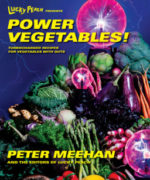
Irreverent, entertaining and just plain fun, Power Vegetables! author Peter Meehan will charm you and your guests into creating and enjoying mains, sides and desserts that taste like exotic treats. They’ll transform underappreciated fruits and vegetables, anew.
Meehan assumes that you’re the reader who has some kitchen/market savvy—or maybe not, you could be inoculated with good taste at the first trial with his recipe ideas. It’s so cool that an omnivore cared so much about taste that he deconstructed plant-based foods to find those irresistible combinations that could fashion a delicious menu any night, certainly any celebration as well. What about Christmas, this year?
7. Japanese Farm Food by Nancy Singleton Hachisu, 2012.
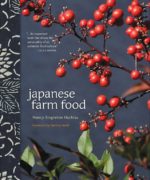
Japanese Farm Food is a beautiful book about food and culture in Japan by an American woman whose life for the past twenty-some years centered around cooking and living in Japanese culture. Everything about the culture that I would expect to see in a book about a “naturalistic” way of life is represented here—the farmhouse itself, antique artifacts, farming tools and modern conveniences. You could have this book in your kitchen—as long as your kitchen affords you a comfortable seat where you can spend hours gazing at the pages inside—and cook Japanese style. Or you could whisk it away to your favorite reading seat, anywhere you’re most comfortable, and savor the chronicle of Nancy Hachisu’s—a California native in Asia—a story of marriage, family, and career created out of love for food.
Tadaaki and Nancy Hachisu, her mother-in-law, three sons, Kitty, and a black Labrador live in a restored 1930s farm house in Japan and are fully conversant with both old and new in the house. They eat according to what’s fresh and available in seasonal produce and tree harvests. So, choose your favorite food type: pickles, soups, soybeans, noodles, meat, eggs, fish, sauces, desserts and sweets, and immerse yourself in the recipes that transport you far away to a legendary kind of life.
8. Sweet Sugar Sultry Spice by Malaika Ameen, 2016.
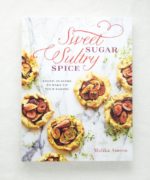
Malika Ameen’s Sweet Sugar Sultry Spice contains all kinds of sweet and spicy secrets. And not only for hot out-of-the-oven treats, but also ice creams, sorbets, drinks, even various preserves. Each recipe is subtly labelled with the featuring spice, be it an herb like Lavender or Lemongrass, a liquid like Orange Blossom Water, Rose Water or Jasmine Green Tea, a seed like Cardamom or Anise or Cumin or Sesame, a flower like Chamomile or Hibiscus…
… Taste euphoria awaita your consideration in Ameen’s 5 sections that characterize a spice and its best sweet pairings in the kitchen. Section One, Spicy and Warm, denotes the heat from certain spices like Ginger in sweet baked goods. Section Two, Floral and Aromatic’s got lighter baked goods and ice creams. In the 3rd section, Bright and Fresh and the 4th, Savory, Earthy and Nutty you find sweet desserts, with an emphasis on lemon verbena, kaffir lime leaves, sumac, and sesame seed, fenugreek seed, poppy seed, respectively. And decadence blossoms in the 5th section, Complex and Mysterious with chocolates, dates, figs for baklava, bonbons, cakes, tortes, even Chocolate Chai Granola.
9. Taste of Persia by Naomi Duguid, 2016.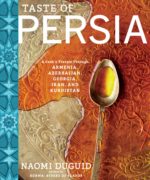
Duguid’s unique style transports you to an adventure to the region, discovering the best Persian, Armenian, Georgian, Kurdestani, and Azerbijani dishes for western cooks to try at home. Photographs by the author, include local people who pose for her camera as if smiling at a true friend and Duguid’s descriptions—of a sauce as easy to make from just a few ingredients—of travelling on the overnight train—of an experience in local culture—of attending a mosque—of living with a Kurdistani family—or the numerous extras like a map of the region, an explanation of the different tribes whose cooking style contributes to the book—all of these enrich the culinary and gustatory experience of these cultures. You are in for a gastronomic journey across borders in the miles of desert, mountain and river terrain of Armenia, Georgia, Iran, and Kurdistan (part of modern Syria). You’ll make condiments, salads, vegetable dishes like eggplant, pates, greens, soups, stuffed vegetables, fish, grilled meats, stovetop rice, breads, sweets, fruits, drinks, fruit leather, and syrups, especially for a regional favorite—sharbat—which is a cross between sherbet and shaved ice. Naomi Duguid is the author of Burma and with Jeffrey Alford of Rice, etc.
10. My Two Souths: Blending the Flavors of India into a Southern Kitchen by Asha Gomez, 2016.
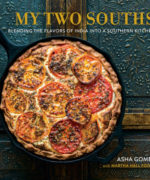
My Two Souths is appealing: first because the cover’s illustration is at once familiar and mysterious. That’s Gomez’ “Vivid Tomato Cheese Pie” baked in an iron skillet and it’s gracing the decorative surface of burnished flowers, over what must be an ancient metal and wood chest of some sort.
My Two Souths is exciting because it represents a conversation between two rich and varied styles of cuisine. Some of the dishes are undoubtedly American in origin—you’ll find recipes for fried green tomatoes, catfish or crawfish, boiled peanuts, and carrot cake. And some recipes are distinctly Indian in origin—you’ll see recipes with the words masala (mixed spices), bhajia (fritters), or vindaloo (meat with wine and garlic). Author Asha’s recipes present a synthesis of two cultures so you’re enjoying the best of both cuisines in each dish.
Sampling an exotic cuisine through the filter of well-known and familiar dishes is one way to experience new tastes and spices that can be purchased in urban area shops and markets. Move over, leading east and west coast cuisines, and make room for a southern accent at the table!
11. The I Quit Sugar Cookbook. / Sarah Wilson, 2015
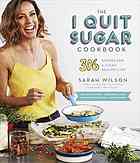
Resolve to cut the white stuff—the SUGAR—from your daily diet. Instead, get naturally sweet! cook whole foods…
… cook whole foods at home with dates, raisins, brown rice syrup, maple syrup or no sweetener at all, in cases where the ingredients are already sweet. The I QUIT SUGAR Cookbook helps you face the challenge! It’s written and lived by Sarah Wilson, a gourmet chef who 5 years ago decided to walk the talk and has over 300 recipes for you in her cookbook.
See a review of The I Quit Sugar Cookbook in my post “Dulce de Leche Naturally Sweet”



